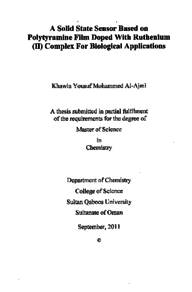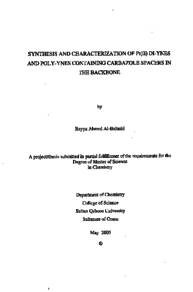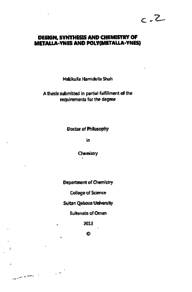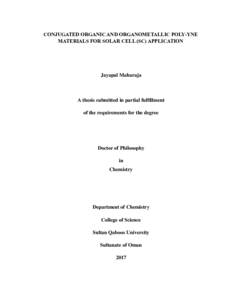Document
A solid state sensor based on polytyramine film doped with ruthenium (II) complex for biological applications
Publisher
Sultan Qaboos University
Gregorian
2011
Language
English
Subject
English abstract
A thin and conductive polytyramine (Pty) film was deposited on the surface of a glassy carbon electrode (GCE) in phosphate buffer solution (pH = 4.07) by reversible potentiodynamic scans in the range of -200 mV to 1000 mV. The reactivity of the polymeric film was characterized using electrochemical methods in the presence of redox couple species and scan rate variations. The amount deposited during the entire repetitive cycles approach 12.96 ug. The mean surface roughness estimated by Scanning Tunneling Spectroscopy (STM) technique is 0.7 nm interestingly insignificant to indicate the formation of a very thin layer. The modified electrode exhibited a substantial reactivity and high sensitivity in the oxidation of dopamine (DA) and ascorbic acid (AA). The symmetry and peak separation for above biological components were identified and the expected interference capacity by either component has been advantageously eliminated to a larger extent. The present working system provides a simple and fundamental approach for the simultaneous and selective determination of DA and AA with a detection limit brought down to 214 nM and 414 nM, respectively but the catalytic activity and separation capacity of the Pty/GC modified electrodes towards the simultaneous determination of DA, AA and uric acid (UA) were not feasible due to interference effect. The presence of UA in the electrolytic mixture with AA and DA inhibits the electron transfer kinetics of DA species which diminishes its peak current. To improve the catalytic activity of the modified electrode, tris(2,22-bipyridyl) ruthenium(II) (Ru(bpy)3]2+ was incorporated on Pty film at GCE. The results show that Ru*2/Pty/GCE is able to successfully detect DA in the presence of large concentrations of AA and UA without any interference. Also, electrode fouling due to the accumulation of oxidation products was not identified as the electrode system sustain good activity and stability even at high initial concentrations of the species.
Member of
Resource URL
Arabic abstract
تم ترسيب طبقة رقيقة وموصلة للكهرباء من بولي تيرامين على سطح القطب الكربوني الزجاجي في محلول الفوسفات معادل الحموضة (درجة الحموضة = 4 . 07) باستخدام مسوحات potentiodynamic العكسية في نطاق -200 مل فولت إلى 1000 مل فولت. تم وصف فعالية الطبقة البوليمرية باستخدام أساليب كهروكيميائية في وجود متفاعلات أكسدة واختزال وإختلاف معدل السرعة. الكمية المترسبة خلال دورات متكررة من نهج کامل بلغت 12 . 96 ميكروغرام. بلغ متوسط خشونة السطح باستخدام المسح الطيفي 0 . 7 نانومتر والتي بدت ضئيلة لتشير إلى تشكل طبقة رقيقة جدا على سطح القطب. أظهر القطب الحور فعالية كبيرة وحساسية عالية في أكسدة الدوبامين وحمض الأسكوربيك. تم تحديد التناظر وفصل القمم للمركبات البيولوجية أعلاه ، وكان من المتوقع التخلص من التداخل. النظام التشغيلي الحالي أعطي طريقة بسيطة وأساسية الفصل الدوبامين وحمض الأسكوربيك للحد الأدني 214 نانومتر و414 نانومتر على التوالي ولكن لم يظهر نتيجة مجدية لفصل الدوبامين وحمض الأسكوربيك وحمض اليورك في وقت واحد بسبب التداخل. وجود حمض اليورك في المحلول مع الدوبامين وحمض الأسكوربيك يمنع نقل الكترون الدوبامين وبالتالي يقلل ذروة التيار. لتحسين نشاط القطب المحور تم دمج ثلاثي (22 - بايبيريدل) روثينيوم (II) على طبقة البولي تايرمين. أظهرت النتائج أن ثلاثي ( 2 ، 2 '۔ بائبیریدل) روثينيوم (II)/بولي تایرمین/ قطب الكربون الزجاجي قادر على كشف الدوبامين بنجاح في وجود تجمعات كبيرة من حمض الأسكوربيك وحمض اليورك ودون أي تداخل. أيضا ، لم يلاحظ تسمم القطب بسبب تراكم منتجات الأكسدة مما يدل ان القطب المعدل يملك نشاط جيد واستقرار حتى بتركيزات عالية من المركبات البيولوجية.
Category
Theses and Dissertations




